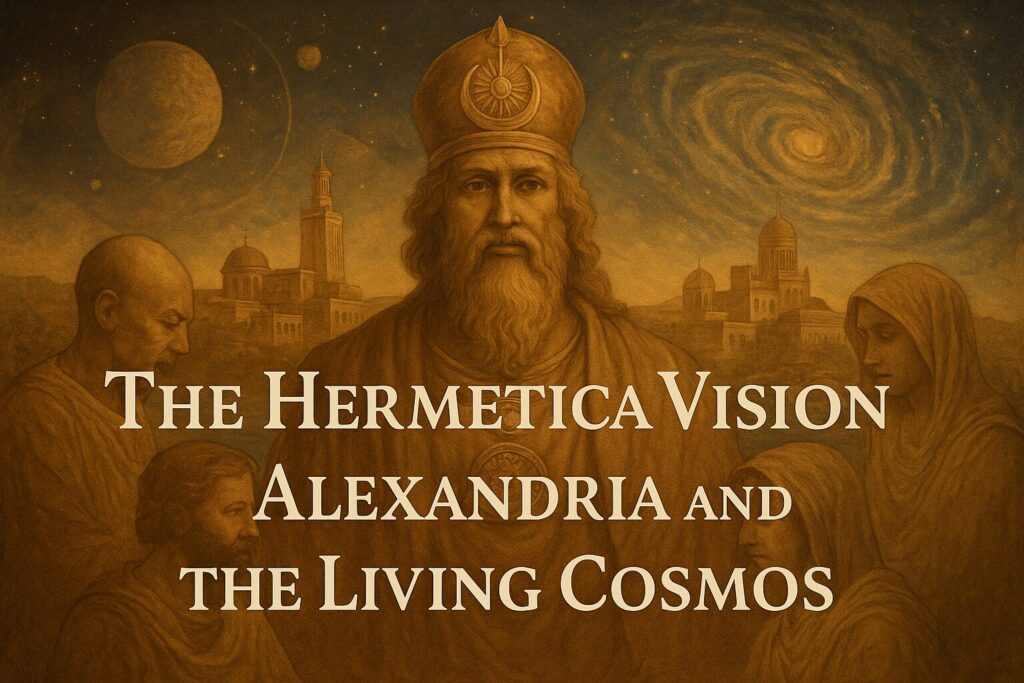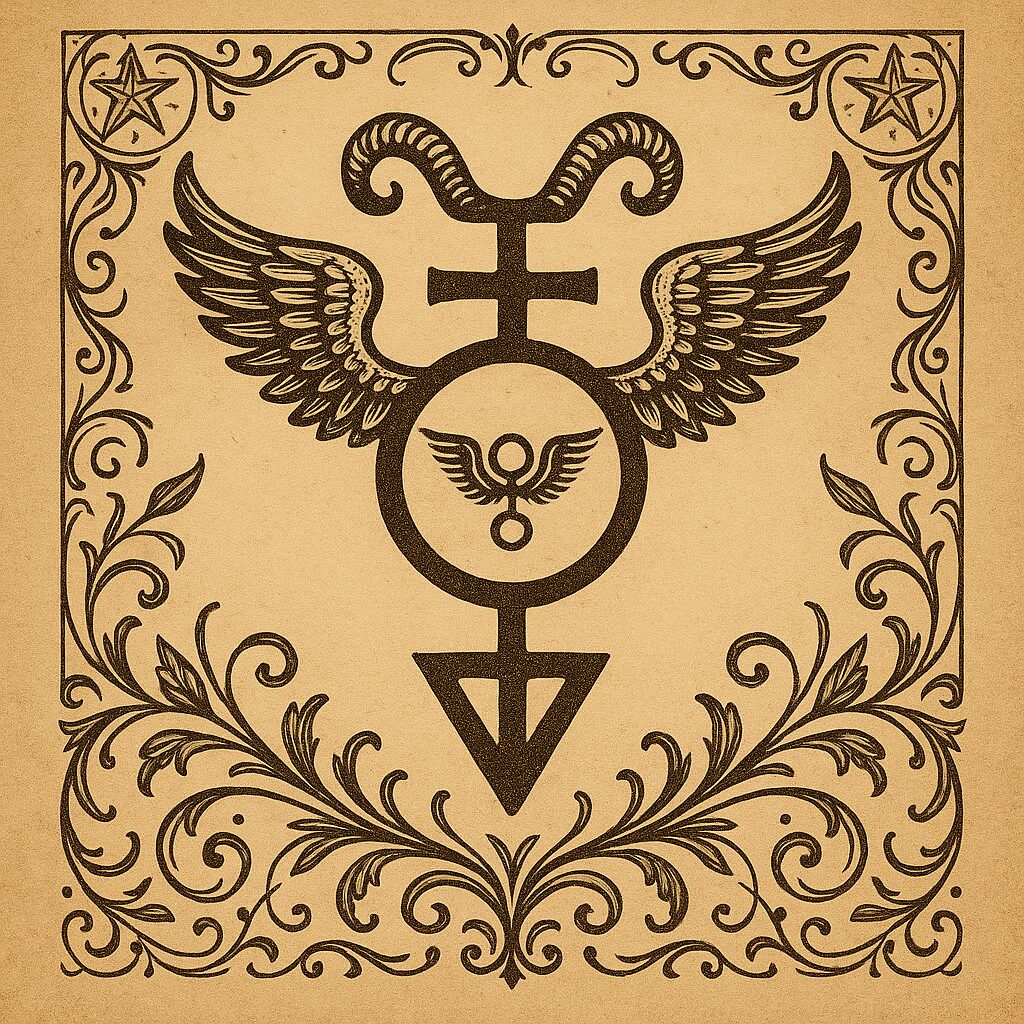
Origins of Hermeticism
Hermeticism was born in Alexandria, a city where the boundaries between cultures and faiths blurred into a single shimmer of ideas. Within its libraries and courtyards, Egyptian priests preserved the memory of temple rites while Greek philosophers debated the nature of soul and cosmos. Jewish mystics read divine patterns in letters, Gnostics sought liberation through hidden knowledge, and Christian theologians struggled to define the contours of revelation. In that confluence of tongues and theologies, a composite figure appeared—Hermes Trismegistus, Hermes the Thrice-Great—a union of the Greek Hermes, guide of souls and messenger of the gods, with Thoth, Egyptian lord of wisdom and writing. Through this fusion, the Alexandrians imagined a universal sage who spoke in all languages of the divine.
The writings gathered under his name—principally the Corpus Hermeticum and Asclepius—describe a living cosmos that emanates from the divine Nous, or Mind. The universe, they insist, is not a mechanism but a breathing order of consciousness. Humanity reflects this divine pattern and may return to its source through gnosis: direct, experiential knowing. “For God is Mind,” one fragment proclaims, “and they that understand are divine.” These texts move between dialogue and prayer, meditation and vision. They are philosophical, yet initiatory; they seek not merely to instruct, but to transform the reader.
The Three Sacred Sciences
Hermes was called Thrice-Great because he was said to have perfected three sacred sciences—alchemy, astrology, and theurgy. Alchemy taught that matter mirrors spirit and that transformation, both physical and inner, proceeds through purification. Astrology revealed the heavens as the script of divine intention, where every star corresponded to a truth within the soul. Theurgy—“god-work”—invoked higher intelligences not to command but to commune, lifting the self toward divine likeness. Through these arts, the adept sought resonance between the human and celestial, discovering the cosmos as a mirror in which the soul might glimpse its own reflection.
Renaissance Rediscovery
Though Alexandrian in imagination, much of the surviving Hermetica was written in the early centuries CE, after Egypt’s ancient temples had fallen silent. Later readers mistook them for primeval scriptures. When they resurfaced in fifteenth-century Florence, they were hailed as revelations older than Plato or Moses. Marsilio Ficino, translating them for Cosimo de’ Medici, saw in Hermes a prophet of the prisca theologia—the ancient theology said to prefigure all later faiths. “All philosophy,” Ficino wrote, “is directed toward one end: the contemplation of God.” To him, Hermes was a gentile sage whose wisdom anticipated Christianity, allowing these works to circulate as learned theology rather than forbidden magic. Yet beneath that pious surface, the old current of Alexandrian mystery still shimmered: talismans, invocations, and celestial correspondences survived as a secret grammar of spirit.
The Renaissance drew immense inspiration from this vision. Ficino’s blend of Platonism and magic gave theology a mystical pulse. Pico della Mirandola wove Hermeticism with Kabbalah, teaching that all faiths spoke one hidden language. Bruno’s infinite universe replaced medieval hierarchies with a cosmos alive at every point. These ideas nurtured the humanist conviction that to know the world is to approach the divine. Later mechanistic science would strip nature of her soul, yet Hermeticism had already whispered a deeper truth: that matter itself is sacred thought made visible.
Magic & Power
The contrast between Hermetic philosophy and folk witchcraft reveals how power once shaped the boundaries of magic. Hermetic practitioners—learned men of letters and patronage—called their art natural philosophy. Cornelius Agrippa’s Three Books of Occult Philosophy mapped correspondences between every level of creation; John Dee conversed with angels through Enochian alphabets; Giordano Bruno envisioned an infinite cosmos alive in every atom and was burned for heresy in 1600. Their learning shielded them only partly.
Meanwhile, village healers and cunning-folk worked with the same forces—herbs, prayers, spirits—but without protection of rank or rhetoric. The difference was not in their magic but in their station. The same ritual of invocation could be philosophy in a scholar’s hand and witchcraft in a peasant’s.
The Invisible Hierarchy
Within Christian Hermeticism, angels and demons were arranged in celestial hierarchies—messengers of light above, rebellious spirits below. Yet modern practitioners often interpret these not as moral absolutes but as currents of energy: constructive or chaotic, luminous or shadowed, but all part of a single continuum of being. The Hermetic magician might invoke an archangel of Venus; the witch might call upon the spirit of love in the land or heart. The languages differ, yet both acts seek relationship with the sacred. The vocabulary divides them; the intention unites them.
The Threefold Practice
Hermetic teaching describes three interwoven paths: Natural Magic, the study of correspondences that bind herbs, metals, colors, planets, and tones in one web of sympathy; Theurgy, the conscious ascent through devotion and insight, joining the human to divine mind; and Alchemy, the art of transformation, turning both matter and soul toward gold. Each reflects the Hermetic maxim: as above, so below; as within, so without. Every operation upon matter mirrors a movement within the spirit.
Seeds of Modern Thought
In the modern era, Hermeticism lived on through revival and adaptation. The nineteenth-century Hermetic Order of the Golden Dawn codified its symbols into ritual practice, uniting Hermetic, Kabbalistic, and alchemical streams. From that lineage came Aleister Crowley’s Thelema, daringly emphasizing True Will as divine vocation: “Do what thou wilt shall be the whole of the Law.” Around the same time, Theosophy and Blavatsky’s writings re-interpreted Hermeticism through an Eastern lens of reincarnation and universal evolution. Carl Jung, reading alchemical texts psychologically, rediscovered their symbols as expressions of inner transformation—proof that Hermeticism describes psyche as much as cosmos.
Meanwhile, modern Witchcraft and Wicca absorbed Hermetic currents almost unconsciously. Circle-casting, quarter calls, planetary timings, and the idea of elemental balance all echo Hermetic correspondences. The witch’s path remains rooted in the earth and moon, while the Hermetic path looks toward the stars—but both continue the same Alexandrian dialogue between nature and mind.
Caution & Ethics
Hermetic study demands humility and discernment. The texts warn that knowledge without purification leads to delusion. Invoking planetary or angelic powers without balance can disturb both psyche and perception. The Corpus Hermeticum counsels: “Let every man know himself, and he shall know the gods.” Self-knowledge is the safeguard of true theurgy. Without it, imagination becomes illusion, and institutions risk turning mystery into hierarchy. Every seeker must test spirits, teachers, and motives alike.
The Living Cosmos
True Hermetic work is neither ornamental nor swift. Its writings are dense, paradoxical, and alive with symbol. Comprehension unfolds slowly, through contemplation as much as intellect. That difficulty is itself initiatory: understanding dawns only when meditation ripens into transformation. To study Hermeticism is to let the universe speak in its own language—the language of correspondence, resonance, and living analogy.
Its central conviction endures: the cosmos is alive, and the human mind participates in that life. We are neither exiled from divinity nor its masters but intermediaries in a sacred continuum. “As above, so below; as within, so without.” To contemplate a star or seed is to glimpse divine mind at play; to act in harmony with that mind is to remember what we are.
The Modern Student
For today’s practitioner, Hermeticism offers a framework rather than a dogma. Its correspondences deepen ritual work, lending rhythm and cosmic geometry to devotion. The witch who honors the quarters may find new resonance in planetary hours and the sacred math of the circle. The ceremonial magician, through theurgy, may rediscover reverence for the living land. Each tradition completes the other. The Alexandrian experiment—melding Greek philosophy, Egyptian magic, and early mysticism—continues wherever knowledge and devotion meet.
To approach Hermeticism requires three virtues: patience, discernment, and humility. Begin with study; the words themselves carry transmission. Read the Corpus Hermeticum slowly, letting its cadence work upon the soul. Seek symbolic understanding rather than literal certainty. Next, practice restraint and grounding—let ritual serve understanding, not spectacle. Finally, cultivate ethical clarity, for in the Hermetic view, the unpurified mind cannot perceive divine truth. The work transforms the worker. As Ficino wrote, “The stars incline; they do not compel. The wise man rules his stars by ruling himself.”
The Enduring Vision
Hermeticism is not a religion in the narrow sense but a way of perceiving reality. It teaches that divinity is immanent, that every level of being participates in the same life, and that knowledge itself is a sacred act. It invites philosophy to become prayer, and prayer to become understanding. For the witch, it affirms that study and ritual, contemplation and craft, are not separate paths but one spiral ascent through the living cosmos.
Hermes Trismegistus remains both emblem and mystery. To the Greeks, a god; to the Egyptians, a priest of wisdom; to Renaissance scholars, a prophet who spoke before Christ; to modern seekers, the patron of occult philosophy. His “triple greatness” may signify the union of knowing, doing, and being—the three degrees of realization. To read him is to enter that process, for Hermetic knowledge is never theoretical; it demands that understanding become embodiment.
The Hermetic vision endures because it reconciles intellect and wonder. It does not ask us to abandon reason but to let reason grow translucent, allowing the light of meaning to shine through. It tells us that the world is not inert matter but divine thought in motion, that every star and stone is a letter in the script of spirit. To learn that alphabet is to join the dialogue of creation itself.
From The Emerald Tablet
From the Emerald Tablet
- That which is above is like that which is below,
- and that which is below is like that which is above,
- to accomplish the miracles of the One.
- All things arise from the One through the reflection of the One,
- and all return by its renewal.
- Its father is the Sun, its mother the Moon;
- the wind carries it in its belly, the earth nurses it.
- Separate the subtle from the gross, with gentleness and art—
- it rises from Earth to Heaven and again descends,
- thus gathering the power of both the Above and the Below.
— Tabula Smaragdina, Hermetic fragment (public domain)
Some Hermetic Correspondences
| Planet | Metal | Colors | Day | Common Herbs | Wiccan Uses (examples) |
|---|
Tip: click a row to see details and a “Point of Interest” in the panel.
Select a term
Click any word from the list to explore its meaning and connection to Hermetic or Wiccan philosophy.
“The old craft has always been a religion of nature and the elements; Hermetic philosophy simply gives us a language in which to understand what the wise once knew by instinct.”
— Doreen Valiente, Witchcraft for Tomorrow

